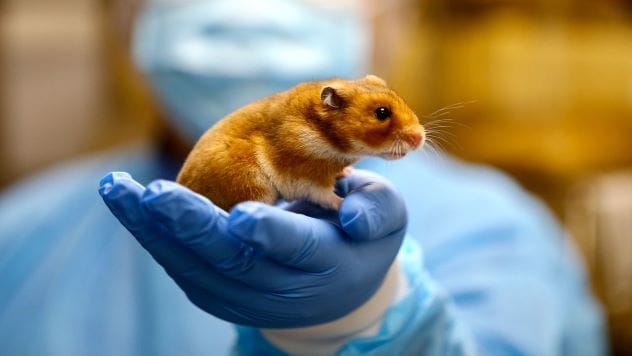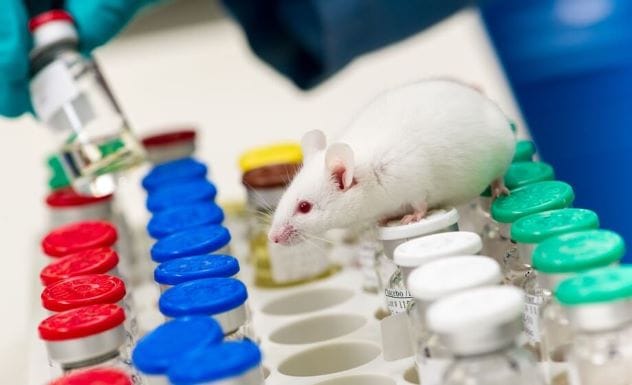Hamsters. Those fluffy, pint-sized companions often bring joy to households, especially those with children. We picture them peacefully nibbling seeds or spinning on their wheels. But what if these seemingly harmless creatures held a darker secret? Prepare to be surprised, as we explore ten shocking incidents where these tiny pets were linked to frightening and even lethal outcomes.
Thomas Magee, 2005
A hamster bite that seemed minor led to an unexpected tragedy in Rhode Island. A woman acquired a new hamster from a PetSmart. During its journey home, the hamster was understandably nervous. While moving it to its new cage, it bit the woman on her finger. The bite was small, just a pinprick, and she didn’t think much of it.
Sometime later, the woman experienced a stroke due to unrelated health issues and, sadly, passed away. Her family, honoring her wishes, allowed her organs to be donated. Thomas Magee was one of the recipients, needing a liver transplant. The surgery initially appeared to be a success. However, just five days after the operation, Mr. Magee developed a high fever and alarming blood pressure levels. Within a month, he tragically died.
The investigation didn’t stop there. The donor’s lungs and a kidney had also been transplanted into two other patients. Both of these individuals also succumbed to illness shortly after their transplants. The cause for these devastating outcomes was eventually identified as Lymphocytic Choriomeningitis Virus (LCMV). This virus can be carried by rodents and transmitted to humans, often through saliva. While LCMV usually causes mild, flu-like symptoms in healthy individuals, it can be fatal for those with compromised immune systems, such as organ transplant recipients. The original hamster bite was the source, transmitting the virus to the organ donor, which then tragically affected the recipients.
Hong Kong, 2022
In January 2022, Hong Kong faced a peculiar situation. A 23-year-old pet-shop worker tested positive for the Covid-19 Delta variant. This was unusual because Hong Kong had been strictly enforcing a zero-Covid policy. Officials, trying to trace the source, decided to test animals at the pet shop where the employee worked.
Their investigation found SARS-CoV-2 in 11 out of 28 Syrian hamsters. It appeared some of these hamsters had contracted the virus in the Netherlands in 2021. The virus then spread among the hamsters during their shipment to Hong Kong. This discovery led to a small outbreak of about 50 Covid cases in humans, which authorities quickly managed to control.
Part of the control measures involved the distressing decision to collect and cull around 2,000 hamsters and other small pets from pet shops. It’s important to note, however, that there was no conclusive evidence that any person had contracted the virus directly from these infected hamsters in this specific outbreak.
Hong Kong, 2013
This wasn’t the first instance of hamsters causing alarm in Hong Kong. In April 2013, an 11-year-old girl was playing with her pet hamster. The small rodent suddenly bit her on the pinky finger of her right hand. The young girl calmly returned the hamster to its cage and went to the kitchen, where her father cleaned the wound.
However, shortly after the incident, the girl began to suffer from cramps and then lost consciousness. She was immediately rushed to the Prince of Wales Hospital in Sha Tin. Tragically, despite medical efforts, she was declared dead shortly after 2 am.
A pediatrician, Dr. Anthony Ng Wing-Keung, suggested a possible cause. Given that the girl was asthmatic, there was a rare but serious possibility that she experienced anaphylaxis. Anaphylaxis is a severe and rapid allergic reaction that can dangerously affect breathing passages.

Ashley Green, 2007
Ashley Green, a father of two from Britain, experienced a terrifying ordeal in 2007. He was playing with Sydney, the family’s pet hamster, when the little creature took a tumble. As Mr. Green tried to catch the falling hamster, it bit him on the hand.
His wife recounted the harrowing moments that followed. “Within seconds, he began to wheeze,” she said. She immediately recognized the signs of a severe allergic reaction because he had suffered a massive anaphylactic reaction to penicillin the previous year. Mr. Green’s face started to turn grey, and an ambulance was called to rush him to the hospital.
Doctors fought for four days to stabilize his blood pressure, which had plummeted dangerously. Thankfully, Ashley Green made a full recovery from the near-fatal incident. The family decided it was best to rehome Sydney the hamster shortly afterward.
North America, 2005
In 2005, a concerning illness affected two young boys in South Carolina and Minnesota. One boy had recently purchased a hamster, and the other had bought a small mouse. Sadly, both pets died shortly after being brought home. The boys’ health began to decline, and soon, others around them started experiencing similar symptoms: abdominal cramps, fever, vomiting, and bloody diarrhea.
In total, six people were hospitalized due to the outbreak. Their symptoms were consistent with severe cases of salmonella. What made this particular strain concerning was its resistance to five major antibiotics: ampicillin, chloramphenicol, streptomycin, sulfisoxazole, and tetracycline.
Despite the severity of the illness and the antibiotic resistance, all 28 individuals who contracted salmonella primarily from the pet rodents eventually recovered.
United States, 1974
A research laboratory in North America became the site of a mysterious outbreak in 1974. Medical staff at the facility began to experience symptoms such as fever, chest pain, and a general feeling of illness or discomfort (malaise).
As the condition of some staff members worsened, blood tests were conducted. The results revealed the presence of Lymphocytic Choriomeningitis Virus (LCMV). This can be a serious condition, potentially fatal, with symptoms that can mimic meningitis and encephalitis. Infected individuals might also suffer from locked neck muscles and seizures.
Fortunately, after a period of illness and treatment, all members of the research team survived the outbreak. However, the incident significantly impacted the lab’s hamster population.

United States, 1942
Another outbreak of Lymphocytic Choriomeningitis Virus (LCMV) occurred much earlier, in 1942. This incident took place at a cancer research facility where workers were involved in handling and breeding small rodents for experiments. The facility had been using specimens infected with LCMV-tumor cells. They had also recently increased both the rodent population and the duration of their experiments.
These factors likely contributed to a significantly higher viral load within the facility. This increased concentration of the virus was considered substantial enough to allow it to jump from the animals to humans. As a result, seven employees at the facility contracted the virus. Thankfully, no fatalities were recorded in this outbreak.

Colombia, 2013
The next few cases on our list involve small pet rodents rather than specifically Syrian hamsters, but the potential for similar viral or parasitic transmission exists. In 2013, doctors in Colombia encountered a puzzling case. A 41-year-old man, who was HIV positive, presented with symptoms including fatigue, weight loss, fever, and a persistent cough. Scans revealed unusual growths in his lungs, liver, and adrenal glands.
The lung scans, in particular, baffled the medical team. The cancer cells observed were incredibly small, about ten times smaller than typical human cancer cells. Furthermore, these tumor cells seemed to be merging, a behavior not commonly seen in human cancers. After three months of intensive testing, the CDC made a startling discovery: DNA from dwarf tapeworms was found within the tumor cells. Tragically, the man passed away just three days after this finding.
The conclusion was that a dwarf tapeworm, which had infected the man, had itself developed cancerous tumors, and these tapeworm cancer cells had spread within his body. Dwarf tapeworms are surprisingly common in rodents sourced from pet shops; one survey found that nearly 25% of hamsters, mice, and rats in pet shops carried Hymenolepis nana, the dwarf tapeworm. Developing cancer from a hamster infected with this tapeworm is extremely rare. Experts believe this tragic outcome was only possible due to the man’s severely compromised immune system (low T-cell count) because of his HIV diagnosis.
United States, 1997
In May 1997, a young farmhand in the southwestern United States began to experience severe respiratory distress. His condition deteriorated rapidly, and he passed away very quickly. Just days before his death, his fiancée had also died in a strikingly similar manner. Initially, medical investigators couldn’t match the cause of death to any known viruses.
Dr. James Cheek of the Indian Health Service (IHS) commented on the significance of the linked cases: “I think if it hadn’t been for that initial pair of people that became sick within a week of each other, we never would have discovered the illness at all.” Soon after, five more people in the Four Corners region died under similar circumstances. The Centers for Disease Control and Prevention (CDC) launched a full investigation, sending tissue samples for analysis.
The investigation eventually narrowed down the virus to a new form of hantavirus. The deer mouse was identified as the primary carrier of this virus in the area, leading scientists to conclude that deer mice were responsible for the rapid spread of the infection. Following the isolation of this new virus, the illness was named hantavirus pulmonary syndrome.
United States, 2013
In August 2013, a 10-year-old child began suffering from vomiting, headaches, and leg pains. His physician initially diagnosed him with a stomach bug and prescribed anti-nausea medication. The child returned home, but over the next three days, his condition worsened dramatically before he suddenly collapsed.
Emergency resuscitation efforts were attempted for an hour but were ultimately unsuccessful. During the autopsy, a small scratch was noted on his body. It was discovered that ten days prior to his illness, the boy had brought home a second pet rat. With this information in mind, suspicions arose. Samples from his liver and one of the pet rats were sent for testing.
The tests returned a positive result for Streptobacillus moniliformis. This bacterium is the cause of “Rat Bite Fever.” It’s estimated that about one in ten bites from an infected rodent can lead to infection. If left untreated, Rat Bite Fever has a fatality rate of around 13%.
These startling stories reveal a hidden side to our furry friends. While hamsters and other small rodents are often cherished pets, they can, in rare circumstances, be carriers of diseases or trigger severe allergic reactions. Understanding these potential risks is crucial for responsible pet ownership, allowing us to enjoy their company while staying safe.
Were you surprised by any of these stories? Do you have your own experiences or tips for safe rodent pet ownership? Share your thoughts in the comments below!










